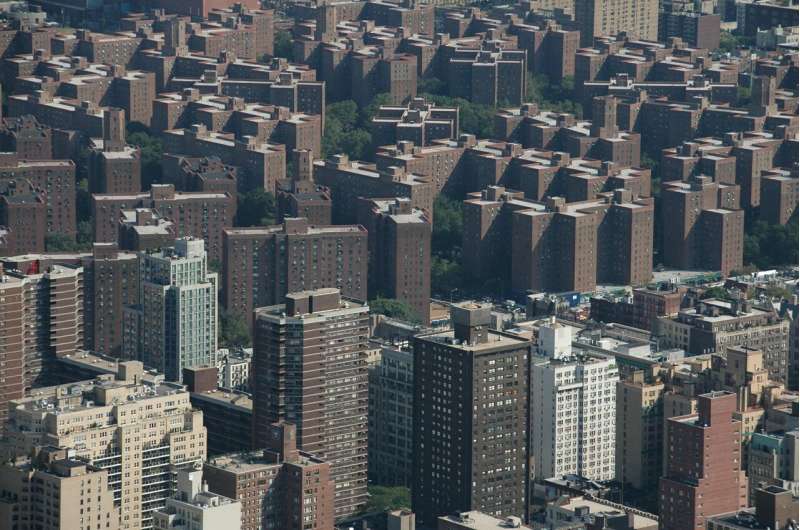This article has been reviewed according to Science X's editorial process and policies. Editors have highlighted the following attributes while ensuring the content's credibility:
fact-checked
peer-reviewed publication
trusted source
proofread
Bronx study tracks exposure to air pollution through the day—data reveal demographic disparities in exposure levels

There are significant differences in how much people are exposed to air pollution, according to a new study co-authored by MIT scholars that takes daily mobility into account.
The study, based in the Bronx, New York, does not just estimate air pollution exposure based on where people live or work, but uses mobile data to examine where people go during a typical day, building a more thorough assessment of the environment's impact on them.
The research finds exposure to particulate matter 2.5 microns or bigger rises by about 2.4% when daily travel patterns are taken into account.
"One of the main strengths of the study is that we try to improve the information we use, on the air quality side and also from the fine-grained estimation of people's mobility," says Paolo Santi, a principal research scientist at Senseable City Lab, part of MIT's Department of Urban Studies and Planning (DUSP), and a co-author of a new paper detailing the study's results.
"That allows us to build trajectories of people's movement. So, it was the first time we were able to combine these data to come up with a new measure of exposure."
After all, people's daily pollution exposure may be a complex combination of either living near, working near, or traveling by sources of particulate matter.
"People move around the city for jobs and education and more, and studying that is where we get this better information about exposure," says An Wang of the Hong Kong Polytechnic University, another co-author of the study.
The paper, "Big mobility data reveals hyperlocal air pollution exposure disparities," is published in Nature Cities.
The authors are Iacopo Testi of the Senseable City Lab; An Wang of Hong Kong Polytechnic University; Sanjana Paul, a graduate student in DUSP; Simone Mora, of the Senseable City Lab; Erica Walker, an associate professor at the Brown University School of Public Health; Marguerite Nyhan, a senior lecturer/associate professor at the National University of Ireland, University College Cork; Fábio Duarte of the Senseable City Lab; Santi; and Carlo Ratti, director of the Senseable City Lab.
To conduct the study, the researchers collected air pollution by mounting solar-power environmental sensors, including optical particle counters, temperature and humidity sensors, and GPS, on New York City's civic services vehicles in operation in the Bronx.
"This strategy shows that cities can use their existing fleet as environmental sensors," says Mora.
To measure how people moving through the Bronx are exposed to pollution at different times, the researchers used anonymized phone records of 500,000 different individuals and 500 million daily location records in New York.
The ground-level pollution data showed that the southeastern portion of the Bronx, where expressways and industries meet most intensively, has the most particulate matter.
The mobility data also revealed disparities in exposure when evaluated in terms of demographics, with income disparities present but disparities by ethnicity larger. For instance, some largely Hispanic communities have among the highest exposure levels. But the data also showed large differences in exposure levels within Hispanic communities.
Pollution exposure has significant implications from a health perspective, as Duarte notes. For instance, the Bronx has the worst air quality of any New York City borough, and, in turn, cases of asthma in the Bronx are 2.5 times higher than any other borough.
"You see the consequences of exposure to pollution in the hospitalization of adults in the Bronx," Duarte says.
As the researchers acknowledge, because the study was conducted in the fall of 2021, when the global COVID-19 pandemic was still affecting business and commuting, there may be slightly different mobility patterns in the Bronx today. Still, they believe their methods can give rise to additional future studies of pollution exposure.
Ratti notes that mobile data, including pollution sensors on vehicles, can be used as "a huge monitoring system. It's not expensive, we have the infrastructure in terms of cars and buses, and just putting sensors on them, you can have better air quality monitoring."
And Wang notes that granular studies such as this one can be extended into studies that add in additional kinds of air-quality hazards, in addition to PM 2.5 particles.
"This actually opens the door for new analysis for many kinds of toxicity studies combined with exposure," he says.
More information: "Big mobility data reveals hyperlocal air pollution exposure disparities", Nature Cities (2024).
Journal information: Nature Cities
Provided by Massachusetts Institute of Technology
This story is republished courtesy of MIT News (web.mit.edu/newsoffice/), a popular site that covers news about MIT research, innovation and teaching.



















